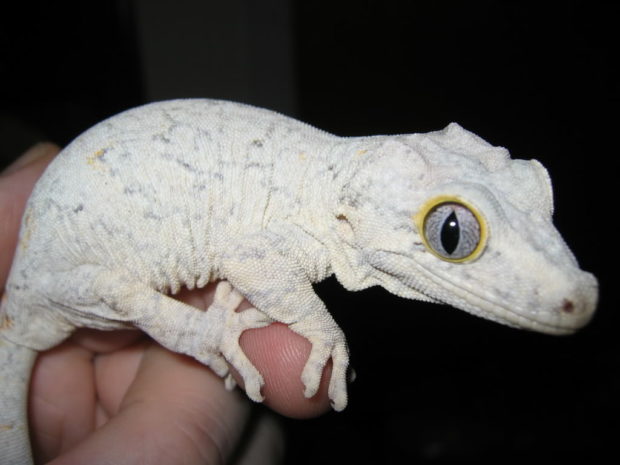Get all information about your pet, ‘’Gargoyle gecko’’ its handling, diet, setup and enclosure. This reptile gets its common name from the cranial bumps that give the appearance of horns or ears; In fact, auriculatus is Latin for “ears” or “eared”, depending on the case.
Gargoyle coloration generally includes earth tones such as creams, yellows, tans and browns, usually with some black patterning. Selectively bred specimens can lack yellow pigment altogether, creating a pure black and white adult coloration, and rare specimens exhibit a deep crimson base color (the latter are highly prized by breeders and collectors). Gargoyle geckos were once considered among the rarest lizards in captivity. Today gargoyle geckos are bred in large numbers and have become standard fare in the pet trade.
Geckos younger than 5 months require special care, and we suggest keeping handling to a minimum until it has settled into its new environment for a week or two. Housing each hatchling in its own enclosure to reduce the risk of tail loss and cage mate aggression is usually the best practice. Small and simple homes are what we recommend to start with when keeping a young Crested or Gargoyle Gecko.
Under proper care, plan for your gargoyle gecko to live 15 to 20 years. Gargoyle Geckos can be a rewarding pet and given some time and bonding, they can become hardy handlers. It’s always important to never grasp or grab your geckos suddenly, this leads to increased stress levels and there is always the possibility that your gecko will drop its tail.
Breeding gargoyle geckos is fairly easy, simply introduce a healthy adult female to a healthy adult male and they will breed. Geckos have a little more breathing room, and are far less likely to drop tails, or show signs of aggression. Screen, plastic, or glass enclosures work, but we prefer glass enclosures for the ability to build a nice looking vivarium within.
What is Gargoyle gecko?
The Gargoyle Gecko has a flattened, triangular head with large eyes. It is called the “Gargoyle” gecko because of the knobs on the top of its head and the large teeth that are reminiscent of stone gargoyles. It has a stocky build. Gargoyle geckos reach a moderate size of 4 to 4.5 inches snout-to-vent length (SVL), and 8 inches in total length. Gargoyle geckos are sexually mature when 15 to 18 months of age, and at a weight of approximately 35 grams.
Gargoyle gecko handling
Gargoyle geckos are among the most handle able of all reptiles. They are typically quite docile and are not prone to biting as long as they are handled properly. When picking up a gargoyle gecko you want to scoop rather than grab. Gargoyle Geckos are very easy to take care of, probably the reason why they are becoming much more popular in the hobby today. They have easily met climate requirements as well as diet requirements. The majority handle well when matured. Care must always be taken though because they have the ability to drop their tail as a defense mechanism. It does grow back. This process can take a lot out of your gecko, if this happens you should ensure your gecko is given a clean and sterile environment with appropriate heating and humidity to ensure the tail area does not become infected.
Gargoyle gecko Setup
Gargoyle gecko setup should be naturalistic it’s important to provide a secondary source of drinking water for hatchlings and juveniles by lightly misting every day or two. Besides stimulating the geckos to drink, this will also help to temporarily boost humidity in the cage, as mentioned previously. Be careful not to saturate the cage. Spraying the geckos themselves can also further stimulate them to drink. Humidity can generally be maintained by a light misting of a cage’s interior every day or two, depending on the humidity in the room itself. Artificial lighting, including UVB, is unnecessary and not recommended due to the potential for overheating the cage. Gargoyle geckos do very well at room temperature, and typically can be maintained without any supplemental heating or lighting. Temperatures in the 75 to 84-degree range with 80 degrees being ideal for juveniles and adults.
Gargoyle gecko Diet
Gargoyle Geckos enjoy a diet of both fruit (non-citrus) and insects. This means that they are omnivorous. There is a specific formulated diet out there that is available for Crested Geckos but Gargoyle Geckos benefit from this formula just as much. It can be made on its own just with water. Some geckos can be reluctant to take to this formula so it is commonly mixed with fruit flavored (peach, banana, apple, pear) baby food to try wean them on to the formula as it is more beneficial for them and it contains all the vitamins and nutrients they need. Supplements and Vitamins are an important part of your gecko’s diet. It is important to use these for appropriate growth and bone development. They should however be used appropriately as too much can be just as bad as too little.
Gargoyle gecko Enclosure
Gargoyle gecko enclosures should be taller rather than longer as gargoyles like to climb and prefer to be up off of the cage floor. A good size tank for a hatchling or juvenile gargoyle gecko is a 10 gallon aquarium or terrarium. As the gecko matures you will need to increase the size of the enclosure. A single adult or an adult pair can be housed in a 29 gallon aquarium or terrarium. Gargoyle geckos need to climb so provide plenty of cage furnishings such as cork bark, driftwood, and artificial vines and plants. Gargoyle geckos tend to be aggressive towards each other and other cage mates so housing each animal individually is highly recommended.




9o4hzk